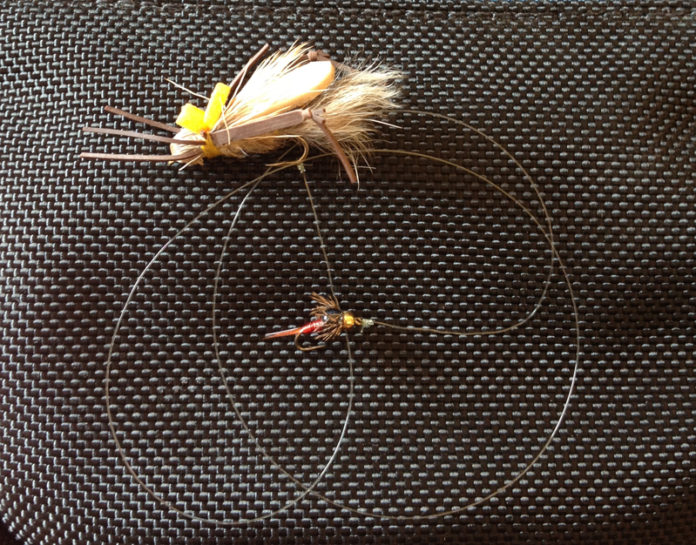Tying the dropper to the hook bend of the top fly is the most common method for creating a tandem rig.
Photo by Phil Monahan
For our “Ask the Experts” Column , we ask you to pose some questions for our panel of experts. Our latest question for them to chew on is: “How do you attach the second fly in a tandem rig: to the hook bend of the top fly, to the hook eye of the top fly, or to the tag end of a knot in the leader?”
Their answers are below. If you’ve got a question you’d like to ask our panel, write it in the comments section below.
Alvin Dedeaux, All Water Guides (Austin, Texas):
I use a regular old clinch knot tied to the bend of the first hook. Fast and easy, and when I want to change droppers or change the length of the tippet, it only takes a couple of minutes.
Joe Demalderis, Cross Current Guide Service (Milford, Pennsylvania):
Most often, I tie the second fly to the hook bend of the first. It’s fast, easy, and it works. The first fly is usually a heavier and larger bug, with the second being smaller Soft Hackle or emerger pattern. Other times, like when employing a contact-nymphing method, I’ll tie to the tag end of a leader knot to either fish separate parts of the water column or to have both flies down on the bottom, depending on weight of the flies. It all works, if you keep your flies in the right place.
Capt. Chuck Hawkins, Hawkins Outfitters (Traverse City, Michigan):
Due to the number of logs left in our streams from the logging era, we do very little nymphing or hopper-dropper fishing. The only time I use double rigs is when streamer fishing. When I use two flies, I attach the second fly to the bend of the first hook.That gives me the correct presentation.
Rob Woodruff, Woodruff Fly Fishing (Norfork, AR):
I prefer to tie to the hook bend of the top fly, using an improved clinch knot. I believe this gives fewer tangles than other methods. I always attach the second fly with a tippet that is one size smaller than what is tied to the upper fly. Since the lower fly is the most likely to snag on the stream bottom or on overhead limb, this insures that I lose just one fly if I have to break it off.
Doc Thompson, High Country Anglers (Ute Park, New Mexico):
With dry-droppers, I tend to either tie off the bend of the dry fly or off the eye of the hook. Sometimes off the eye gives a little better or quicker sink rate to a beadhead dropper. It does sometimes create more casting tangles, and if that’s the case, I tie off the bend.
With tandem nymphs, it’s about a half-and-half split between tying off the eye of the hook or off the tag end of a knot. The deeper I fish, the more tendency I have to tie off the tag of a knot, as I think it gives the rig a quicker sink rate. On smaller water with double nymphs, I typically go off the eye of the front hook. Once again, tangles can dictate some of that.
Brown Hobson, Brown Trout Fly Fishing (Asheville, North Carolina):
That’s a hard question to answer quickly because they all have their time and place. Most often, I attach to the bend if the hook has a barb or mashed barb. I always use the bend if I’m fishing a nymph rig with split shot. If the hook is a manufactured barbless hook that wont work. The clinch knot just slides off and the dropper is gone. I’ll use tags if the flies have no barbs or remnants of barbs. I also use tags when fishing deep nymphs with no splitshot. The tag allows for the flies to move around in currents that aren’t moving perfectly horizontal to the bottom of the river, and allows flies in different parts of the water column to move independently of each other. I only use the eye knot when fishing a dry fly with hackle around the thorax. I think the dry fly rides better when the dropper is off the eye.
Mike Canady, Ellensburg Angler (Ellensburg, Washington):
I tie it directly to the bend of the first hook, using an improved clinch knot. I use this method as it seems to hinge well and is fairly fast to tie.
Credit: Source link































